High Blood Pressure – What High Blood Pressure is. Why High Blood Pressure happens. What to do!
This is not just another article on high blood pressure or hypertension. The perspective is entirely different as you will find. Clearly, the accepted understanding of what high blood pressure is, seems to be inadequate as it offers few solutions.
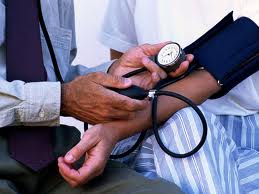 A few thoughts come to mind when dealing with the problem of high blood pressure. First of all it must be remembered that pressure is pressure no matter in what system it is being created in. This means that if that pressure is high, low or uneven within any system the principles that would govern it should be identical whether that system is mechanical or biological.The point being, that biology without giving much regard to physics is like building a brick wall without using any mortar – concepts built upon it will be weak.
A few thoughts come to mind when dealing with the problem of high blood pressure. First of all it must be remembered that pressure is pressure no matter in what system it is being created in. This means that if that pressure is high, low or uneven within any system the principles that would govern it should be identical whether that system is mechanical or biological.The point being, that biology without giving much regard to physics is like building a brick wall without using any mortar – concepts built upon it will be weak.
In order for matters to do with health to make sense they need to be based on very basic fundamental principles that are as much valid outside of the body as they are inside it. Otherwise, it is easy to get lost in unnecessarily complex ideas or, empty baseless speculation making for very thin logic and even weaker science.
The human body is a closed system containing more than one circulating fluid. In the natural view the body circulates blood, bile, water and air through ducts or vessels that carry them throughout the body. Each fluid is of a different density and viscosity. If we are concerned with blood flow and the pressure within the blood vessels, a simple mechanical analogy could be constructed to represent that circulation and necessary pressures needed to maintain a normal flow of fluid.
A Mechanical Model Showing High Pressure
Imagine a simple pump connected to a closed loop of pipes that when operating circulates a fluid within it. Now picture an adjustable valve placed along that pipe just before the pump and one just after the pump that could be made to restrict the flow of fluid into and out of the pump while it is in operation. Also consider the viscosity of the fluid being circulated because clearly, pumping a fluid like water is a lot easier than say a denser fluid like a thick oil.
The valve placed just before the pump would control the fluid going into the pump and the one just after the pump 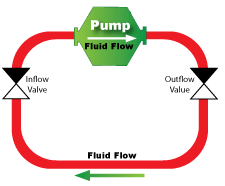 would control the fluid exiting from the pump. Clearly, when both valves are wide open there is no obstruction to the fluid flow making it relatively easy for the pump to make the fluid circulate.
would control the fluid exiting from the pump. Clearly, when both valves are wide open there is no obstruction to the fluid flow making it relatively easy for the pump to make the fluid circulate.
In order for any fluid to flow within a biological vessel or a mechanical system, it must be forced by some sort of pressure. (Within the complexity of a living organism circulation is also assisted by other means) Let’s say the pump is capable of producing a pressure within its loop of pipe of 10 psi (pounds per square inch). Provided the pump has been designed to deliver sufficient force to produce that much pressure to a system of that size it should feel absolutely no strain when operating with both valves wide open.
As long as both valves before and after the pump are kept wide open the pump will work with little effort and the pressure will stay pretty much constant. But, if the valves are made to restrict their flow somewhat, it is obvious that the pump, through no fault of its own, would have to strain to do it’s job.
If the valve before the pump is restricted, the pump will struggle because it is having a hard time drawing the fluid it needs to circulate creating a low pressure situation between the valve and itself. However, since the pump is still exerting pressure against a closed loop and that fluid is being forced to back up behind the slightly closed valve, the overall system will experience high pressure (high blood pressure).
On the other hand, if the valve after the pump is restricted, the pump will again struggle because of back-pressure from that restriction, creating a high pressure situation between itself and the valve because the pump is not capable of getting rid of fluid fast enough. The result is that the pressure in the overall system would drop. (low blood pressure)
Should the valves on both sides of the pump be gradually restricted more and more what could we expect to happen to the pump? Eventually, it would overstrain itself, burn-out or seize (cardiac arrest or heart failure). If the fluid being circulated were to be a thicker fluid it is obvious that it would further strain the pump and damage it a lot sooner from overwork. And, if more fluid were forced into the system it would pressurize it, straining all parts including the values intended to control the flow of liquid.
High Blood Pressure In The Human Body In Principle
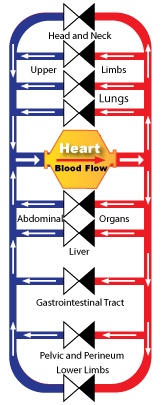 Now picture the same scenario within the body. Unlike in our mechanical analogy, in the human body there are thousands of valves and valves within valves of different types throughout the body along the circulatory paths of arteries and veins. Some are actual valves as in the veins of the legs but, each major organ also acts like a valve of sorts in the overall circulatory system and within each organ flow is restricted through progressively finer capillaries. When all is clear within the circulatory vessels there is no effect from a valve-like restriction. When there is, is when we start having health problems.
Now picture the same scenario within the body. Unlike in our mechanical analogy, in the human body there are thousands of valves and valves within valves of different types throughout the body along the circulatory paths of arteries and veins. Some are actual valves as in the veins of the legs but, each major organ also acts like a valve of sorts in the overall circulatory system and within each organ flow is restricted through progressively finer capillaries. When all is clear within the circulatory vessels there is no effect from a valve-like restriction. When there is, is when we start having health problems.
Oxygenated blood is carried by arteries out from the heart and is returned back to the heart through the veins after having gone through every part of the body. Generally, (there are more details) the blood goes into one end of an organ, splits into thousands of smaller capillary vessels within the organ and then is transferred over to tiny capillary veins and comes out the other end of that organ.
Under normal healthy conditions when there are no obstructions anywhere along the arterial or venous blood flow there is little resistance; blood flows freely, blood pressure is even and normal. Should obstructions occur that would restrict blood flow from anywhere along that flow cycle, including within the organs themselves, that restriction would create the same situation depicted above in the mechanical example of fluid flow.
Although obstructions can occur anywhere along the bloods flow, the two organs that are the most active in filtering and removing fine waste from the blood, are the liver and the kidneys. They each have a high concentration of veins and arteries going through them for the purpose of processing blood in uncountable ways. And, it would be completely logical that because they, as specialized filters, are handling fine wastes that they would be prone to different types of congestion based on the types of wastes consistently passing through them that could produce stagnations in blood flow within them, making it entirely conceivable that they could indeed influence blood pressure through restriction.
The liver is a major organ that precedes the heart in the natural circulatory/energy pattern. If it is clogged, there will be back pressure behind it, creating a high blood pressure situation.
When a person has had high blood pressure for a long time it is expected that they will have other issues related to it. And, it is completely logical that those issues will be partly due to abnormal pressure differentials in different parts of the body due to blockages that in their absence would have otherwise disbursed that pressure more evenly over the entire body.
Kidney issues are also common from high blood pressure but, with the kidneys it is also a little more complicated. First of all the Kidneys are designed to filter finer liquid waste out of the blood rather than the more “courser” wastes out of the blood that the Liver is very capable of removing from circulation. Should the Liver, be itself incapable of removing these more “solid” wastes from being itself congested, that would leave that task to the Kidneys, something they are not capable of doing, at least not for long. That is where the “turbidity” in Kidney fluids can come from to produce Kidney stones, gout, sciatica, arthritis and so on.
You then have a situation where not only is the pressure back-up causing a high blood pressure situation systematically, you now also have a filter who’s internal filtration system is also clogged, creating internal pressures that are magnified because of their further restriction within tiny renal capillaries and in danger of failing. That is a strain that would make most machines break down.
This situation forces the Kidneys to overwork and can lead to eventual Kidney failure from a sort of Kidney fatigue. It is quite conceivable that this issue is not so much from the systemic blood pressure itself but from the congestion in the kidneys that could have caused the high blood pressure in the first place. The high blood pressure being the effect, not the cause. And, often the chemicals given to counter high blood pressure, being quasi poisons in themselves also tend to further weaken the Kidneys.
Although this may be analogous, this is much more than just a mere “valve failure.”
Besides congestion or stagnations within organs it is also possible for the blood itself to become laddened with substances that should not be circulating within it because of Liver and Kidney impairment, making it harder for the blood itself to flow freely. Undigested fats are known to clog up the main arteries. The question is how does that fat get as far as it does and why.
Throughout all this it is not the heart that is at fault, it is just made to struggle a little or a lot harder than it would normally have to, producing things like irregular heart beats or even skipped beats from the strain of working against unnatural pressure from unnatural congestion.
The Body Saves Itself Through High Blood Pressure But, Not For Long?
As unlikely as it would seem, in a sense, high blood pressure, although not good for our general health, is the bodies only possible natural response at it’s disposal for keeping itself supplied with sufficient blood to maintain it’s vital functions in the face of unnatural obstacles and obstructions that would prevent it. In other words, high blood pressure comes into being to save a persons life from abuses they have made to their own body or from exposure to substances that A) impair organ functions, (fluid retention) B) affect blood viscosity or, C) create flow restrictions. The body can only keep it up for so long before the strain on the Heart and Kidneys makes them give out. Or, in an attempt to clear an obstruction, the body produces a stroke.Sometimes it works – sometimes it kills you. (this last statement is based on the writings of Paracelsus)
Blood is important but, it’s not the only fluid circulating to keep the body alive.
It is also possible and entirely conceivable for all four of the main fluid types circulating within their own vessels throughout the body to become impeded along their flow from similar causes. One has to consider that if there are other fluids in the body besides blood that they must circulate and be regulated by some organ in their flow.
For the Blood it is clear that the Heart is it’s regulator. And, besides clogged arteries and clogged organs, when blood is made to stagnate in it’s flow it can also produce such things as tumors from things backing up and accumulating. For the Bile, it’s the Gallbladder with some help from the Liver so, when lymphatic fluids are too congested our lymph areas swells because they have reached their limit of saturation from the overflow of toxins from the blood and tries to use the skin pours at various points as a possible release valve. For the Water, it’s the Kidneys, aided by the Lungs. When our waters are obstructed and cannot flow freely we swell with retained water; no different than when a river is dammed. For the Air, it’s the Lungs. When air is trapped we bloat or sometimes even experience a tremor or even extreme pain or cramps. The mechanism for these occurrences are very simple in principle. Examples of them are to be seen throughout Nature.
How Does High Blood Pressure Happen?
The next question is why would, from an otherwise essential bodily function like the circulation of bodily fluids, could the body create such a situation like this within itself and how does it do it?
Digestion is the key to controlling bodily fluids and blood pressure. The recent interest in insulin levels in relation to blood pressure is very late in coming but although thin, it establishes that the digestive process is indeed tied to blood pressure issues, something that was well known among alternative practitioners even if they did not quite understand the mechanism by which it related.
At present, MD’s more interested in healing versus merely treating are suggesting that the “vast majority of people don’t need prescription drugs to normalize blood pressure. In most cases, hypertension can be reversed with a few basic adjustments to diet and lifestyle.” In the natural food camp, this too has been known for over 100 years or longer. We are glad to finally see this now old information creeping or limping its way back into the mainstream.
Undigested fats are finding their way into the blood because the body’s ability to deliver sufficient bile in the digestive process while they are in the process of digesting has been inhibited from the Liver and Gallbladder being congested (hardened bile). Bile in sufficient quantity renders fats water soluble, more easily metabolized and less likely to cause problems.
Bile, Insulin And Their Connection To Digestion And High Blood Pressure
The “Bile/Insulin” story doesn’t end there. There is a bile duct that leads right into the Pancreas. Is there a relationship between bile flow to the Pancreas and the ability of the Pancreas to produce insulin? Basic anatomy would certainly suggest it. That said, the current preoccupation with the relationship between insulin resistance along with all that goes along with it and high blood pressure is justified.
A lack of insulin has several effects. From lack of insulin the body does not metabolize magnesium and retains sodium among many other anomalies. Magnesium has a dilating effect on the blood vessels; lack of it constricts them causing blood pressure to rise. While, retained sodium causes water retention also affecting blood pressure. These are interesting, pertinent and contribute to high blood pressure but are only secondary effects – not causes.
The main point is that due to a lack of insulin, blood sugar elevates because sugars are not being completely digested in the stomach, some proceed into the blood stream in an undigested form where they then ferment into several other compounds that should not be in the blood stream. According to Traditional Herbal Theory, sugar is the enemy of the Kidneys which, as previously indicated, contribute to high blood pressure for several reasons including how they deal with minerals. Once affected in this way everything to do with health quickly becomes a downward spiral.
What to do?
Some solutions are implicit in this article, like removing the obstructions, others are simply a matter of intelligent dietary choices, that over a period of time have a similar but often a less complete effect.
Foods Are The Ultimate Remedy
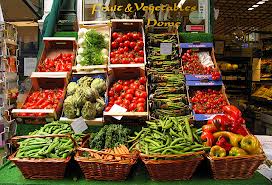 Foods as a solution to health issues have been downplayed so severely for nearly a hundred years, as to have been rendered insignificant as both the cause of many ailments and the remedy for their removal. Most of the highly publicized diets are fad driven, short term marketing blitzes that need to be taken with a good measure of common sense. Fasting has been a traditional way of dealing with some ailments and if the documentary Fat, Sick and Nearly Dead is any indicator, it looks like it is still quite relevant as a way of helping people.
Foods as a solution to health issues have been downplayed so severely for nearly a hundred years, as to have been rendered insignificant as both the cause of many ailments and the remedy for their removal. Most of the highly publicized diets are fad driven, short term marketing blitzes that need to be taken with a good measure of common sense. Fasting has been a traditional way of dealing with some ailments and if the documentary Fat, Sick and Nearly Dead is any indicator, it looks like it is still quite relevant as a way of helping people.
The non-fat diet has finally been put back into it’s genie bottle and sunk to the bottom of the ocean – hopefully for good. People have been eating long before our high tech world came into being. Yet, despite our many technical advances, people are sicker per capita than ever before. There are many reasons why but, that is a subject all its own. It is enough to know that our food has changed, our lifestyles have changed, our attitudes have changed and our connection to our foods and where it comes from have been minimized – all fertile ground for misleading marketing to drag us everywhere but where we should be.
Carbs, Fats and Proteins
Foods are categorized in a limited way that often make little sense. People argue over carbohydrates, fats and proteins as though once a food has been categorized into one of these groups, it is equal to every other food categorized with it under the same label. The reality is that no two foods are equal, all carbohydrates are not the same, same goes for fats and proteins.
Technically, a doughnut is just as much a carb as an apple or oatmeal. Anyone with an ounce of sense would say, “Hold it! There is no way that they could be.” These three foods don’t act the same when eaten!” They may be similar chemically but by no means are they equal!
Fats are not all the same. Olive oil is a technically a fat, but so is margarine, so is an avocado, so is the fat in meats, so is frying grease. Does it really take a degree in nutrition to determine that they are not all equal?
Cleansing the body is not everyone’s cup of tea. That said, a few simple, common sense dietary suggestions may be enough to help some people help themselves with their blood pressure issues.
Healthy Fats
Healthy fats are now “in” and it’s about time too! They have been known to be non-problematic and healthy for thousands of years. So it is not a revelation and even redundant to suddenly make it official that they are now good for us. Obviously, someone, somewhere was working within a very narrow scope or dealing with incomplete information and passed it on as fact.
- Oils like olive oil, walnut oil, coconut oil, palm oil, flax or hemp oil are all extremely beneficial as long as they are ingested in their raw form.
- Organic butter made from milk from healthy cows is finally considered good for everyone again.
- Raw nuts like almonds, walnuts and pecans have always been good for anyone.
- Ripe avocados are a fruit that is a great source of good fat.
- Eggs have had an “on-again off-again” relationship with dietitians in spite of always having been a great food. Finally they have gained favor with the “experts.” Let’s see how long that favor lasts.
- Nothing is wrong with meat now. Not that there ever was but, with the questionable modern methods of growing it, it is likely a good idea to make sure that if you are eating meats that they be organic and pasture fed.
- Fish has always been a great food but currently the concern over mercury has many worrying about it. The farmed fish, like the factory farmed meat, is likely not much better. Some still prefer fish over meat but, trying to buy what ever happens to be wild caught is getting harder.
Why have all these fats finally finally been deemed good for us to eat now? If you want to read through all of the confusing reasons that had previously made them a bad food choice and why now justify the eating of these otherwise great foods go right ahead. It’s everywhere online. The reality is that apart from the nutritional value that these foods provide, good fats have a solvent like effect that help dissolve bad or accumulated fats. They are completely digestible and are untraceable once assimilated providing the body with the fatty acids it needs to produce other nutrients some known but, many likely still unknown.
It is in the nature of fats to prevent and help dissolve things that have hardened in the body and it makes sense that the omega-6 or omega-3 fats found in animal products and fish would build strong cell membranes, maintain good arterial elasticity and are also the building blocks for many other nutrients.
What Has Become Of Grains?
Another food group that is being vilified is grains. How is it that what were once the “staff of life” are suddenly on 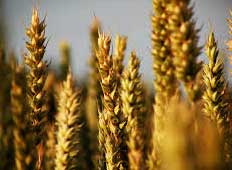 a health hit list? Simple, the grains are not what they used to be. They’ve been hybridized and modified to death (GMO). Add to that, that because the natural nutrients in them are worth more than the grain itself, the grain is often stripped of it’s nutritive value to be turned into supplements and all you have left is a depleted white powder that is largely glutton. In fact it is illegal to seel wheat four without some of the nutrients that had been stripped out of it to have been replaced to some measure. The flour is then called “enriched;” but, how could it be?
a health hit list? Simple, the grains are not what they used to be. They’ve been hybridized and modified to death (GMO). Add to that, that because the natural nutrients in them are worth more than the grain itself, the grain is often stripped of it’s nutritive value to be turned into supplements and all you have left is a depleted white powder that is largely glutton. In fact it is illegal to seel wheat four without some of the nutrients that had been stripped out of it to have been replaced to some measure. The flour is then called “enriched;” but, how could it be?
Needless to say, after having spoken about the clogging of arteries and veins, what effect would eating a non-food, white powder have other than thickening and really gumming up internal fluids. Thickening them to where all they do is impede fluid flow with it’s accompanying problems. Unless you are heavily into phlegm, clogged organs and a lumpy butt they are best avoided unless you can find grains that are whole and organic and have the will to make foods from them from scratch.
What About Fruit?
Fruit are a great food too! They always have been up until recently. Presently, because of the anti-fructose movement, this particular carb group is on a hit list. It will likely take some time to clear up this one just as it did with some of the other foods mentioned above that were once also considered “evil” but are now deemed good for us, the pendulum will likely one day swing back in favor of fruit.
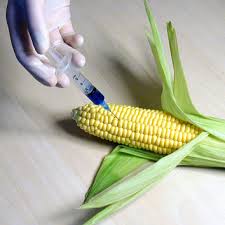 This mess likely started with the very real problems that “high-fructose corn syrup” produced from genetically modified corn have been tied to. Fructose is definitely a fruit sugar but just like all carbs are not equal fructose from fruit is not equal to high fructose corn syrup, even if they have a similar molecular structure. For a while there were even commercials being run to convince us that they were. If you have to try that hard to convince people of something, you know it smells fishy. Whether it has equivalency with it’s corn derived chemical equivalent will likely get resolved in time hopefully in favor of fruit.
This mess likely started with the very real problems that “high-fructose corn syrup” produced from genetically modified corn have been tied to. Fructose is definitely a fruit sugar but just like all carbs are not equal fructose from fruit is not equal to high fructose corn syrup, even if they have a similar molecular structure. For a while there were even commercials being run to convince us that they were. If you have to try that hard to convince people of something, you know it smells fishy. Whether it has equivalency with it’s corn derived chemical equivalent will likely get resolved in time hopefully in favor of fruit.
The other problem with fruit is not the fruit itself; it’s the fact that for the most part, buying a fresh ripe fruit anywhere is nearly impossible unless you are growing it yourself. Most fruit is picked green. Not only does it bother the stomach when eaten in that premature state but, it just isn’t good for you fructose notwithstanding. Fresh Sun ripened fruit however, if you can still find it, is from a health, taste and digestive point of view, a night and day experience.
Fruit is also being hybridized to be sweeter at the expense of it’s full spectrum of nutritional value. Look for organic fruit that has not been tampered with if you want fruit.
Making Changes
Improving general health through diet and physical activity is not that hard. Sure, one has to give up what is obviously detrimental and replace it with something sensible but, like everything we are all already doing, we are creatures of habit. Once we start on a new regiment we tend to stay with it, if we have a mind to.
- You’ll be hard pressed to find any health professional suggesting that getting some fresh air isn’t good for you. (the problem is finding fresh air that is clean) And while you’re already in the outdoors taking in a few Sun rays to get your dose of free vitamin D is a good idea too. If your diet is clean, the odds of the Sun causing any problems are minimal. If it weren’t, everyone on Earth would have been killed by the Sun a very long time ago. Some like to take a vitamin D3 supplement during the winter months to compensate for not being outside.
- If you already happen to be outside, connect with the Earth as much as you can; kick your shoes off and walk barefoot on the grass for ion exchange. Not only is it soothing, it has what some have called a “grounding” effect. This is a very old concept that not only feels great, it is soooo relaxing. If you’re by a beach, a barefoot walk in the surf will exfoliate the soles of your feet and make them smooth and soft. Believe it or not, actual experiments have shown that walking barefoot outside improves blood flow because it modifies blood viscosity helping regulate blood pressure.
- Exercise can be something as simple as a regular daily walk that can get progressively longer or more vigorous. One good rule of thumb is that when walking for the sake of health, it is helpful to keep in mind that in order for the walk to be more beneficial, it should be continued until you at least break some sweat. The heat generated in any physical activity is the start to the simplest form of detoxification; sweating. Before the body prepares itself to sweat from exertion, its heat accumulates and starts to “pressurize” its internal moisture to start moving and eliminating latent accumulation from throughout the body out through the skin pores. If it didn’t, sweat would have no odor. The benefit is obvious. With less accumulations within the body, the less likely they are to mix with the blood affecting it’s viscosity. Anyone can extend a simple walk to what ever they’d like; including weight training or the like.
- Replacing junk foods in any form with real foods is not that hard to do but, it can be tricky because many of these foods have additives that make them addictive – food science at work (a very well researched fact). Once people start eating real food long enough they tend not to go back to fast foods or heavily processed foods because real foods taste better and they feel better eating them. Residual cravings from the old foods are to be expected.
- Proper elimination is a much ignored cornerstone of good health and sometimes many resort to a mild laxative tea. A teas is fine but, it is not a good idea to addict the bowels to anything for the sake of provoking what should be their normal function. It is far better and more efficient to eat foods that are in themselves laxative, stool softening or bowel tonifying. Kale, whole flax seeds, asparagus, leeks, etc
- Fermented foods are being talked about presently as though they had never existed before. The fact is that fermented foods like sauerkraut, yogurt, buttermilk, keifer, real organic cheeses (not the processed “cheese-food”), and so on have been staples for entire cultures for a very long time. Sauerkraut is of Chinese origins and was adopted by the Germans when they were active in that area of the world. Kale is bowel tonifying, mineral rich and extremely nutritious. Asparagus is an excellent for Kidney, Heart and the whole body. All of these foods help the heart not just nutritively but also by helping maintain the bowels and the bowel flora. Fermented foods are good because in the process of fermentation they release what is in them that would otherwise cause them to rot. Once fermented, they preserve themselves and when eaten do not cause bloating because the bloating element in them had been eliminated through fermentation.
- It goes without saying that if you are already suffering from high blood pressure that anything that would affect your internal fluids, set your nerves on edge or act as a stimulant is best avoided. That means avoiding caffeine. Caffeine acts in the general area of the Kidneys and Adrenals. Further substantiating the relation of Kidney function to blood pressure.
- Finally, whatever can be done to lesson stress is always beneficial in assisting with lowering high blood pressure. If all you need is something like meditation, prayer or yoga that is fine too, other wise there are some great supplements just for stress.
There is a possible simple solution to blood pressure problems that is worth considering.
Page still under construction.




